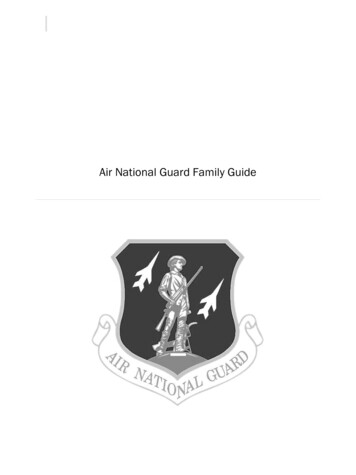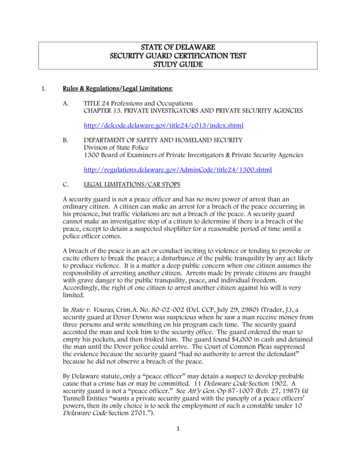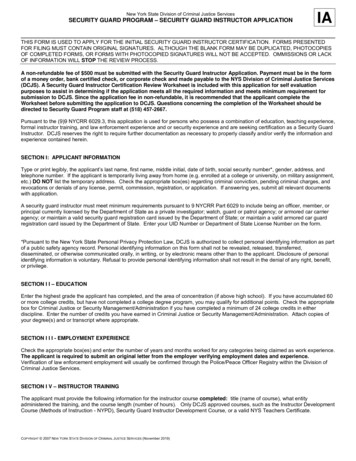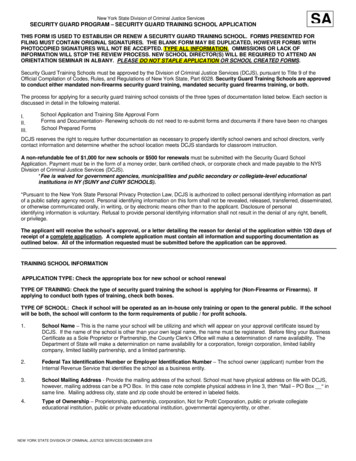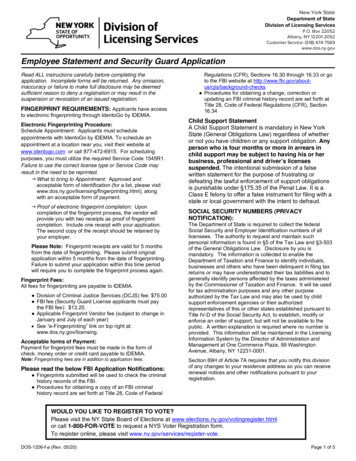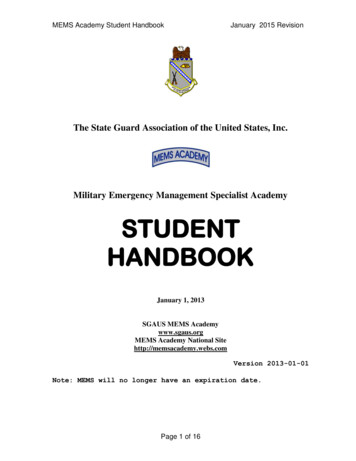
Transcription
MEMS Academy Student HandbookJanuary 2015 RevisionThe State Guard Association of the United States, Inc.Military Emergency Management Specialist AcademySTUDENTHANDBOOKJanuary 1, 2013SGAUS MEMS Academywww.sgaus.orgMEMS Academy National Sitehttp://memsacademy.webs.comVersion 2013-01-01Note: MEMS will no longer have an expiration date.Page 1 of 16
MEMS Academy Student HandbookJanuary 2015 Revision“The credit belongs to the person who is actually in the arena; whose face ismarred by dust and sweat and blood; who strives valiantly; who errs and comes upshort again and again; who knows the great enthusiasms; the great devotions, andspends himself in a worth cause; who, at the best, knows in the end the triumph ofhigh achievement; and who, at worst, if he fails, at least fails while daring greatly,so that his place shall never be with those cold and timid souls who know neithervictory nor defeat.”Theodore RooseveltI. Commander’s WelcomeCongratulations - you have taken an important first important step on the way to earn qualificationas a Military Emergency Management Specialist (MEMS) and the coveted MEMS skills badge! TheMEMS Academy is a unique program, designed to prepare military personnel to effectively functionin and operate local or statewide military Emergency Management mobilizations.The Academy qualification program fully complies with current US Department of HomelandSecurity (DHS), Federal Emergency Management Administration (FEMA), Incident CommandSystem (ICS), National Incident Management system (NIMS), National Response Framework(NRF) and Homeland Security Presidential Directive 5 (HSPD-5) and (PPD-8) requirements foremergency management personnel.The qualification process is not easy; it will take effort, perseverance and time to complete. It willchallenge you! Though the curriculum emphasizes actual experience, most course work can becompleted online. This handbook will help you work with the MEMS Academy staff to obtain yourMEMS qualification.I wish to thank LTC (WA) George Heart, founding Commander of the MEMS Academy, and allthose who have worked to create and nurture it. I would also like to thank Maj. Roger Higby formentoring me in this position as well.Finally, as the 2011 MEMS Academy Commandant, I would also like to thank Major Roger Higbyfor all his past work with the MEMS Academy, as your Past Commandant. He had endured thehardships of command and has prospered through the tough times of the academy. His efforts willnot be forgotten. I have some big shoes to fill, and I plan to be a proactive leader in this role. I willbe looking to the leaders of the MEMS Academy to step up to the plate and take charge. I will beestablishing some basic policies to keep this program and its integrity in tack. I expect the leadersto do the same. Together we can make this program a great success. HOAAAH CSM Tim White, Indiana Guard ReserveCommandantMEMS AcademyPage 2 of 16
MEMS Academy Student HandbookJanuary 2015 RevisionII. Mission StatementThe Military Emergency Management Specialist (MEMS) Academy was established by the StateGuard Association of the United States, Inc. (SGAUS) in 1998 to promote and advance the practiceof emergency management among the various State Guards (State Defense Forces, State MilitaryReserve, or similar terms) and similar organizations.III. Goals and Introductory Notes1.Members of the U.S. Uniformed Services and State Guards increasingly have beenmobilized to respond to natural and man-made disasters and other emergencies. Militaryand civilian authorities now see an urgent need to provide additional and improvedemergency management training for troops deploying for emergency response.2.The MEMS Academy program prepares military personnel to effectively function in andoperate local or statewide military Emergency Management mobilizations.3.The MEMS Academy offers qualifications as a Basic, Senior and Master MilitaryEmergency Management Specialist and confers appropriate insignia of qualification.4.Individuals with Basic MEMS qualification will have operational understanding of theprinciples of emergency management, including mitigation, preparedness, emergencyresponse and recovery and have knowledge, skills and abilities needed to effectively workwithin a comprehensive emergency management operation. Those with Senior and Masterlevel qualification will be able to lead and plan incident response efforts of increasingcomplexity.5.Uniformed and civilian members of the State Guards, Military Reserves, State DefenseForces, Medical Reserve Corps, U.S. Uniformed Services and other MEMS Academyapproved official military and civilian organizations are eligible to earn MEMS qualifications.6.Individuals need to be members of SGAUS to enroll in the MEMS Academy and earnMEMS credentials. However, the MEMS qualification program is offered free of charge toSGAUS members in good standing. Fees to defray program costs are charged for nonSGAUS members.7.MEMS qualification recipients who have actually deployed into emergency operations mayqualify for award of the MEMS Flash. Students with advanced emergency managementtraining and experience may receive waivers for some Basic and Senior –level MEMSqualification requirements. College credit may be available from Towson University(Maryland) or other colleges for completion of some MEMS Academy courses and practicalassignments.8.Unlike the past the MEMS program had an expiration date to ensure that members wouldkeep up their skills. Based on the SGAUS Conference of 2012, that is no longer the case.You must be a SGAUS member to earn the badge, but you do not have to maintain it tokeep and wear the badge depending on your State Guard policies.9.Wearing of the MEMS insignia on official uniforms is dependent on the policy andauthorization of the respective military competent and uniform authority, not MEMSor SGAUS.You must be a member of SGAUS to earn the badge, but you do not have to maintainthat membership to wear it, if your state authorizes it. Special Note: You must be amember to Purchase MEMS regalia10.Page 3 of 16
MEMS Academy Student Handbook11.January 2015 RevisionMEMS Academy curricula consist principally of standardized and validated coursesdeveloped by FEMA’s Emergency Management Institute (EMI). Most are available on-linebut may be available as in-person group presentations. A few advanced classes areavailable only in classroom or resident settings.12. Almost all courses in the MEMS curricula are available free of charge. However, Academyenrollees are responsible for all expenses, if any, incurred in the course of theirparticipation.13. Student that are taking Direct or Indirect courses from FEMA will now have to have aStudent ID number prior to attending the course. The student may attain this number bygoing to the following website and registering for it.https://cdp.dhs.gov/femasid/14. The new MEMS application doesn’t require a MEMBERS Number now, it requires theexpiration date of your membership.This is a permanent ID number from FEMA.IV. Applying to and Completing the MEMS Program1.Complete, print out and sign an application to the MEMS program, available on-line at SGAUS.org or in Appendix A. Be sure to obtain verification / endorsement by yourmilitary or civilian supervisor. If you do not have a supervisor, contact your state or regionalAcademy Director.2.Submit to your state or regional Academy Director – see Appendix B to this Handbook – bymail, fax or as an e-mail attachment your application form and a civilian curriculum vitaeand / or military biography including a list of relevant emergency management experienceand coursework you have completed. You must submit proof of completion of coursework,e.g., copies of certificates or transcripts. Contact the state or regional director before yousend materials to assure you have up-to-date contact information, submit all neededinformation and to assure secure delivery of possibly sensitive information. DO NOT submitapplications to the SGAUS national office. If you are missing any documentation, contactyour Academy Director for additional instructions.3.If you are a member of SGAUS, send proof of current membership along with yourapplication, e.g., a current membership card, copy of a current addressed newsletter, amembership certificate issued within a year of application or a life membership certificate.4.If you are not a member of SGAUS, you must pay the necessary enrollment fee before youcan participate in the program. Payment should be made by check or money order in U.S.funds, payable to “State Guard Association of the US.” Mail your payment to the SGAUSExecutive Director along with your application. If your payment does not clear, yourparticipation in the MEMS program will automatically be suspended and will not bereinstated unless and until payment is made for the program fee and any bad checkcharges.5.A separate application must be completed and fee paid, if necessary, for advancement inlevel, for example from Basic to Senior.6.The State Academy Director will review your application. If the application is accepted, thedirector will act as your proctor or will assign an Academy Instructor to act in that role. Ifyour application is not accepted, your application will be returned (along with your payment,if any).Page 4 of 16
MEMS Academy Student HandbookJanuary 2015 Revision7.As the science and practice of emergency response changes, and standardized coursesare brought up to date, the MEMS Academy may change requirements for qualification atdifferent levels. If a required course becomes unavailable, state and regional directors maywith consent of the Academy Commander, direct substitution of equivalent courses.8.Academy participants should maintain personal files of their work and training certificates.To protect the student’s privacy, the MEMS Academy does not maintain detailed files on itsstudents. The MEMS Academy will keep a record of program qualifiers’ date and level ofMEMS qualification, name, rank, military / agency affiliation, and contact information as oftheir date of qualification.9.Upon completion of training, graduates will receive notification and a qualificationcertificate. Copies of the certificate may be placed in the graduate’s military or civilianpersonnel records jacket. A copy of the notification or certificate must accompany requeststo SGAUS to purchase MEMS insignia.10. If a student is currently working the 2013 Student criteria, they will have 120 days tocomplete the program, from the positing of this 2015 revision. If the program is notcompleted in that timeframe, then the student will have to revert to the currentcourse standardsV.1.Basic MEMS CurriculumComplete, as a minimum, the following online EMI courses:NOTE: These courses are available online, free of charge, at the FEMA web site underTraining, Independent Study Program (ISP): http://training.fema.gov/emi/web/is andmay be available in group, in person settings.a.b.c.d.e.f.g.2.IS100.b Introduction to Incident Command System (NIMS)IS200.b ICS for Single Resources and Initial Action Incidents (NIMS)IS775 Emergency Operations Center (EOC)IS701 Multi-agency Coordination Centers (NIMS)IS700.a National Incident Management System (NIMS)IS800.b National Response Framework (NIMS)IS 75 Military ResourcesComplete a Basic MEMS Practicum assigned to you by your Proctor. This will be either:a. A minimum of a Tabletop Exercise (4 hours Recommended)b. An Event planned under Incident Command principlesc. An incident controlled by Incident Command processes3.Complete a Basic After Action Report or Narrative on the practicum option assigned. Thisshould include, as indicated:a.b.c.d.e.f.The title of the Basic Narrative.Names and addresses of agencies with which the practicum was performed.Contact name and title of agency Points of Contact.Rank, name, and contact information, including email, of the commanding officer oragency supervisor that approved this practicum.Dates of practicum activities.A detailed description of what you did and accomplished.Page 5 of 16
MEMS Academy Student Handbookg.h.i.k.l.January 2015 RevisionAn assessment of how the training and experiences of this practicum assist you infuture emergency management activation(s) with your unit/organization?As assessment of how will you use MEMS qualification in your military/agencycareerSuggestions and recommendations to improve MEMS trainingCopies of all class notes and any course curricula from the training.Copies of any orders you received, After Action Reports and other documentsrelevant to the practicum.After completion of the Basic MEMS curriculum, participants will understand the principles ofemergency management including the National Response Framework, National IncidentManagement System and Incident Command System, and have knowledge necessary to workwithin an incident response.VI. Senior MEMS Curriculum1.Complete, as a minimum, the following online EMI courses, in addition to those required forthe Basic MEMS Qualification:NOTE: The following courses are available online, free of charge, at fema.gov under Training, Independent Study: http://training.fema.gov/emi/web/is and maybe available in group, in person settings. ICS300 and 400 are available inclassroom format only, not online. State Emergency Management Offices (or theirequivalents) provide information on available classes at this level.AWR 160 WMD, may be found at the following locationsNew Mexico Tech website, TEEX website or the LSU website.Special Note: Online Course will not be honored for MEMS, FEMA no LongerRecognizes them.a.b.c.d.e.f.g.h.i.k.IS139 Exercise Design or IS 120 (Note: IS 139 is only good till 2015)IS230.d Principles of Emergency ManagementIS235.b Emergency PlanningIS240.b Leadership and InfluenceIS241.b Decision Making and Problem SolvingIS242.b Effective CommunicationIS244.b Developing and Managing VolunteersIS 26 Points of DistributionICS300 Intermediate Incident Command SystemAWR 160 Weapons of Mass Destruction Awareness*2.Complete a Senior MEMS Practicum assigned to you by your Proctor. This will be either:a. A minimum of a Tabletop Exercise (4 hours Recommended)b. An Event planned under Incident Command principlesC. An incident controlled by Incident Command processesd. Must have a completed ICS form 203 with you in a leadership positionsigned by the Incident Commander3.Complete a Senior After Action Report or Narrative on the practicum option assigned. Thisshould include, as indicated:a.b.c.d.e.The title of the Senior NarrativeNames and addresses of agencies with which the practicum was performed.Contact name and title of agency Points of Contact.Rank, name, and contact information, including email, of the commanding officer oragency supervisor that approved this practicum.Dates of practicum activities.Page 6 of 16
MEMS Academy Student Handbookf.g.h.i.k.l.January 2015 RevisionA detailed description of what you did and accomplished.An assessment of how the training and experiences of this practicum assist you infuture emergency management activation(s) with your unit/organization?As assessment of how will you use MEMS qualification.Suggestions and recommendations to improve MEMS trainingCopies of all class notes and any course curricula from the training.Copies of any orders you received, After Action Reports and other documentsrelevant to the practicum.After completion of the Senior MEMS curriculum, participants will understand the principles ofemergency management including the National Response Framework, National IncidentManagement System and Incident Command System, have completed the FEMA EMI ISPProfessional Development Series, and have knowledge necessary to act as a manager within anincident response.VII (a). Master MEMS Qualification (Non Trainer Certification)Master MEMS qualification is the “capstone” of the MEMS Academy.1.Applicants must have Senior MEMS for at least 6 months before applying for Master level.2.Applicants are expected to have participated at a high level in planning and execution ofemergency plans, exercises and emergency responses.Experience in leadership of actual emergency activation(s) may, on a case by case basis,be counted as partial fulfillment of the teaching requirement.Must have a completed ICS Form 203 from the Full Scale ExerciseComplete, as a minimum, the following online EMI courses, in addition to those required forthe Senior MEMS Qualification:IS 702.a Public Information SystemsIS 703.a NIMS Resource Management CourseIS 19.14 FEMA EEO Supervisors CourseIS 706 Interstate Mutual Aid, An IntroductionICS 400 Moved from Senior to MasterNote: Non Trainer Master must complete at least on ESF course in their Professional/Militaryexpertise.3. MASTER MEMS Practicuma. Be involved in a Full Exercise and being listed on the ICS Form 203b. Be involved in a real world incident and being listed on the ICS Form 203, orc. Write a Table Top Exercise for a disaster; implement all the forms of ICS 300, ICSForms 201, 201, 203, 204, 205, 206, 211, 215 215a. Put on the Table top and submitan AAR to the ASD and Commandant.4.Complete a Master After Action Report or Narrative on the practicum option assigned. Thisshould include, as indicated:a.b.c.d.The title of the Senior Narrative.Names and addresses of agencies with which the practicum was performed.Contact name and title of agency Points of Contact.Rank, name, and contact information, including email, of the commanding officer oragency supervisor that approved this practicum.Page 7 of 16
MEMS Academy Student Handbooke.f.g.h.i.k.l.January 2015 RevisionDates of practicum activities.A detailed description of what you did and accomplished.An assessment of how the training and experiences of this practicum assist you infuture emergency management activation(s) with your unit/organization?As assessment of how will you use MEMS qualification.Suggestions and recommendations to improve MEMS trainingCopies of all class notes and any course curricula from the training.Copies of any orders you received, After Action Reports and other documentsrelevant to the practicum.After completion of the Senior MEMS curriculum, participants will have knowledge necessary toteach at advanced level principles of emergency management and to act as a manager at a highlevel within a complex incident response.VII (b). Master MEMS Qualification (Master Trainer Certification)1.Applicants must be ‘train the trainer’ certified’ in and have taught several emergencymanagement-related categories, e.g., Community Emergency Response Team (CERT),ICS NIMS (L449), NRF, and have advanced practical experience in Emergency OperationsCenters2.An Applicant with a Train the Trainer Certification will not have to complete theother IS Courses outlined in the Non Master Certification, and have up to 8 hours ofevaluated classroom instruction.VIII. MEMS Flash1.MEMS badge recipients may earn the MEMS Flash, denoting actual emergencymanagement activation and mobilization in response to a disaster or emergency.2.To apply for the MEMS Flash, contact the appropriate state or regional Academy Directorand submit documentation of the recent emergency management activation(s). The proofmust link the applicant specifically to the activation. Acceptable documentation includes:a.b.c.d.e.5.Copies of competent military ordersAfter Action ReportsOther military papers, documenting such service.Newspaper and magazine articles/stories.Formal letters from appropriate military and/or governmental authorities attestingthat the applicant actually served in a management position during an emergencyactivation.The appropriate state or regional Academy Director authorizes the MEMS Flash, adds theawardees name to the MEMS Academy records and issues a certificate of award. Theletter of notification or certificate must accompany requests for purchase of the MEMSFlash from SGAUS. See Section X for more information about the MEMS Flash.VIII. College and Continuing Education Credit1.Many FEMA, EMI and USFA online courses will qualify for college and ContinuingEducation Unit (CEU) credit. Various Emergency Management classroom courses mayalso qualify for credits. Contact either FEMA for more information sp or talk to your Academy proctor.Page 8 of 16
MEMS Academy Student Handbook2.January 2015 RevisionThe MEMS Academy, in a cooperative agreement with Towson University in Baltimore,Maryland, may also grant college credit for the experiential practicum portions of the MEMSqualification process and other relevant classroom and academic work. Contact theTowson University Liaison for more information.4. You may also check with your local community college if they offer college credit for EMIISP courses. Contact your Academy State Director for more information.5.The MEMS Academy has entered into an agreement with Indiana University/PerdueUniversity of Indianapolis in to awarding CEUs for the MEMS program. There is a smallcost for obtaining the CEUs.a. Basic MEMS 1.7 CEUs Cost 25.00b. Senior MEMS 3.7 CEUs Cost 35.00c. Master MEMS 4.7 CEUs Cost 50.00Enrollment dates are set by the MEMS CommandantClasses for certification are set up by the MEMS CommandantIX. Waivers1. There are no waivers for course work done in the Basic MEMS program. Law Enforcementand other EMS personnel will be waived from doing a separate Practicum. However, theywill have to still write and AAR on an event or incident they did under ICS. That is it.2. Senior MEMS: If a member has a degree in Emergency Management; the only waiver willbe for the Professional Development course in ICS at the EMI site. This degree issupposed to cover this training. This is the only waiver for Senior MEMS.3. There are absolutely NO Waivers for Master MEMS.Waiver of any requirements are not guaranteed, rarely granted and will be granted only inrecognition of significant, demonstrated experience at a level appropriate to thequalification level involved. Waivers will not be granted on account of rank, service to orposition in any organization, military or civilian, including SGAUS or the MEMS Academy.X. MEMS Skills Insignia1.The MEMS Skills Badge depicts the historic United States “Civil Defense” eagle of WorldWar II rampant on a bound laurel wreath, the ancient symbol for victory.2.The MEMS Skills badge is authorized in Basic, Senior and Master Versions. The SeniorMEMS Skills Badge has a five pointed star added above the eagle. The Master MEMSSkills Badge has a five pointed star in a circular laurel wreath added above the eagle.3.The Basic, Senior and Maser MEMS skill badges are authorized in full and miniature silverhigh-gloss metal finish, full size subdued black metal finish and as full-size subdued blackor white on olive drab sew-on patches. MEMS skill badges are worn in accordance withapplicable military regulations. That is, generally centered above or below military ribbonson the left side of military dress uniform shirts or jackets. On combat-type uniform blouses,the badge is worn on the left chest - either centered above the branch name tape or below,on a pocket flap. ACU Sew on patches will be available soon.4.The MEMS Flash patch has a light blue background with a gray border, denoting the colorsof the State Guard Association of the United States. The MEMS badge is centered on theflash and generally worn only on dress uniforms.Page 9 of 16
MEMS Academy Student HandbookJanuary 2015 Revision5.Official wear of all MEMS skill badges and patches is solely dependent on military ororganizational authority and not SGAUS or the MEMS Academy! Consult your militaryauthority on official wearing guidelines.6.All SGUAS and/or MEMS Academy artwork and designs used as and in the varioussymbols, patches, badges, emblems, and insignias, altered or not, are proprietary toSGAUS and the MEMS Academy and may not be reproduced, used, manufactured orotherwise copied, duplicated, replicated or otherwise disseminated, distributed or circulatedwithout the express authorization of the SGAUS Board of Directors and/or the MEMSAcademy Executive Council. Violation of this policy are prosecutable by state andfederal criminal and civil lawXI. Suggestions for Practicum Assignments1.The following is a partial list of agencies you can contact for practicum and/or trainingpurposes:a.b.c.d.e.f.g.h.i.j.2.Local emergency managers.Local Fire and/or Police Departments – in many rural areas, emergencymanagement falls to the police or fire departments.County emergency managers.County Sheriff or metropolitan police department – some states mandate the sheriffis responsible for emergency management.State office of emergency management.Large corporations – many large corporations have their own emergencymanagement programs and officials.FEMA regional headquarters – contact information is available on www.fema.govAmerican Red Cross.Your state Military Department.Your State Guard.Contact your Academy proctor for more suggestions.The following is a partial list of practical assignment suggestions you may want to considerfor your practicum:a.b.c.d.e.g.h.i.j.k.l.Community Emergency Response Team (CERT) disaster exercises.Department of Homeland Security disaster drills.Federal Emergency Management Agency (FEMA) disaster drills.State or Local Office of Emergency Preparedness (OEP) disaster exercises.Fire Department disaster exercises.Local Hospital disaster exercise.Accredited University Level disaster or emergency exercises.Participation in a civilian or military emergency management training exercises.Multi Agency Exercise involving EOC or Incident Management Teams.Participation at an EOC at a major planned event, i.e. major festival, concert, etc.Contact your Academy proctor for more suggestions.3.There are other courses that may meet classroom course requirements. Contact yourAcademy proctor to determine if you have specific courses in mind. For additional listings ofall state delivered emergency management courses, contact your state department ofEmergency Management or go to: .For FEMA and EMI resident emergency management courses held at Emmetsburg, MD,contact FEMA directly.Page 10 of 16
MEMS Academy Student HandbookJanuary 2015 RevisionXII. Student Information1.STUDENT CONDUCT: Every student admitted to the MEMS qualification process isexpected to treat Academy staff, fellow students, outside instructors and others with properrespect, dignity and military courtesy. Violations of this rule may result in dismissal from theMEMS Academy.2.STUDENT ETHICS: Students will adhere to the highest standards of personal and militaryethics while enrolled in the MEMS Academy. Any cheating, falsification, dishonesty, ordeception will result in immediate dismissal from the Academy. If it is learned that a studentreceived a MEMS qualification under deceitful or dishonest conditions, his/her qualificationrevoked at any time by the Academy Commander.3.STUDENT ISSUES: Students that encounter problems or concerns with their academystudies and/or assignments are encouraged to resolve any issues informally with theiracademy proctor. If this approach does not lead to resolution, the student may informallycontact the Academy State Director about the issue(s). If this does not resolve the problem,the student may write a formal request to the Academy Regional Director to address his/herissue(s). If the Regional Director is also not able to resolve the issue, the matter will beforwarded to the MEMS Academy Deputy Commander and, if necessary, to the AcademyCommander for resolution. The Academy Commander's decision is final.XIII. Legal Disclaimer1.All MEMS Academy students and participants, by their involvement in the qualificationprogram and process, acknowledge that they have reviewed the requirements and fullyunderstand the MEMS Academy program, are fully familiar with the potential hazards,potential for injury, illness or damage, and, have read or materials describing it, and haveotherwise evaluated the potential for injury and resulting damages and understand thatparticipation in the program can be a strenuous event.2.SGAUS and the MEMS Academy require as a condition of participating in the MEMSprogram, that each student, in consideration of permission to enter this activity, irrevocablyrelease and forever discharge SGAUS and the MEMS Academy (collectively, ‘they’ ‘their’),their heirs, executors, administrators, personal representatives, assigns, and anyoneentitled to act on their behalf, their agents, servants, and employees, sponsors, owners ofthe property on which program related training is conducted, their promoters, managers,instructors, inspectors, officials, volunteers, and any and every other person participating inany way, from any and all claims for damages or injury or liability of any kind, illnessesalleged to result from the training or damages of any and every kind suffered, as a result ofparticipating in or travel to or from training exercises or courses. Also students furtheragree to indemnify and hold harmless those released for costs, attorneys fees, or otherexpenses should the student or any person for or on the student’s behalf file a legal actionagainst the United States of America, the various States, territories or commonwealths,SGAUS, the MEMS Academy or anyone else involved in the MEMS Academy qualificationprogram.3.For more information contact the MEMS Academy JAG.XIV AppendixPage 11 of 16
MEMS Academy Student HandbookJanuary 2015 Revision1. MEMS Academy Staff Public Roster as of November 2012-2013.Academy State and Regional Directors (ASD & ARD)Academy Regional Directors (ARD) supervises ASDs within their region and function as ASDs forstates/areas within their region that do not have an assigned ASD. ARDs provide Academy QualityPlan assurance functions for their regions.Academy State Directors (ASD) coordinates and provides lo
MEMS Academy Student Handbook January 2015 Revision Page 3 of 16 II. Mission Statement The Military Emergency Management Specialist (MEMS) Academy was established by the State Guard Association of the United States, Inc. (SGAUS) in 1998 to promote and advance the practice of emergency management among the various State Guards (State Defense Forces, State Military



